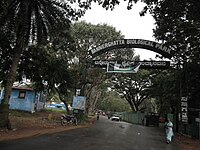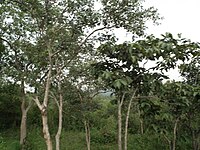| Bannerghatta National Park | |
|---|---|
 Tiger at the Bannerghatta National Park | |
| Location | Karnataka, India |
| Nearest city | Bangalore |
| Coordinates | 12°48′03″N77°34′32″E / 12.80083°N 77.57556°E |
| Area | 260.51 km2 (100.58 sq mi) |
| Established | 1974 |
| Governing body | Ministry of Environment and Forests, Government of India |
| bannerghattabiologicalpark | |
Bannerghatta National Park is a national park in India, located In Bengaluru and Ramanagara District, Karnataka. It was founded in 1970 and declared as a national park in 1974. [1] In 2002, a small portion of the park became a zoological garden, the Bannerghatta Biological Park. [2]
Contents
- Geography
- Water sources
- Flora
- Fauna
- Illegal mining around Bannerghatta national park
- In popular culture
- Gallery
- See also
- References
- External links
There are ancient temples in the park for worship and it is a destination for trekking and hiking. Within the national park area are six rural villages enclosed within three large enclosures for sheep and cattle farming. [3] This park offers a wide range of diverse wildlife to the explorers. Coming from the finest of Bengaluru, Karnataka, this park offers a guided bus tour all along the 6 km safari roads, which is specially made for safaris and foreign tourist gatherers.
Between 1995 and 2021, the dry deciduous forests in the National Park shrank by approximately 44% due to uncontrolled diversion of forest land for agricultural purpose, urbanisation, etc. [1]











